Companies
A manager can view the configuration of this virtual representation and edit it to a limited extent. This applies both to the company to which the manager belongs and to the descendants of this company.
Companies
There are two distinct types of companies: reseller and customer.
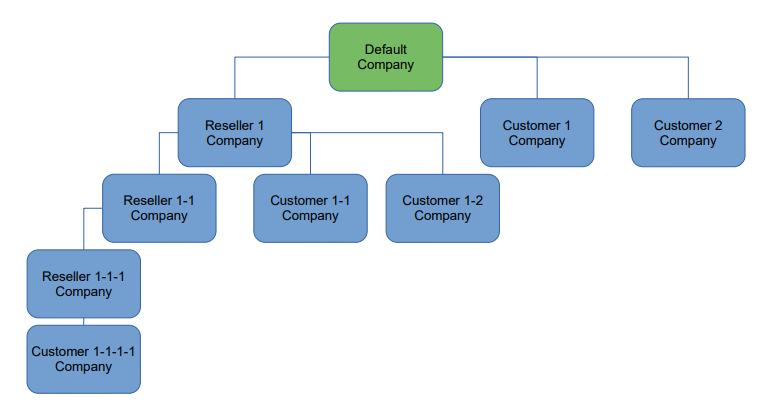
A reseller company can be parent to one or multiple reseller and customer companies. It must itself be part of a parent reseller company. The exception to this rule is the root company (the default company in the depiction), which stands as the highest company in the hierarchy. Depending on the acquired license, a DataForge manager with the requisite permissions can create additional companies. A company with sub-companies cannot be deleted, and its type cannot be altered from reseller to customer. Customer companies must belong to a reseller company and cannot have child companies.
The root company, also called instance, offers additional features beyond conventional reseller companies and is explained in more detail in the DataForge admin manual.
A super admin of the root company or a custom manager role with the necessary permissions has unique capabilities. They can enable or disable modules and set quotas for other companies. Further information can be found in the chapter Modules and quotas.
Creating companies
A customer company can be created by a manager with the Company ACLs if the necessary quotas are available. A reseller company also requires the general permission Can create reseller company.
To create a company, navigate to Administration > Companies, which displays a list of companies including the company you belong to and its descendants. Click the blue plus to create a new company:
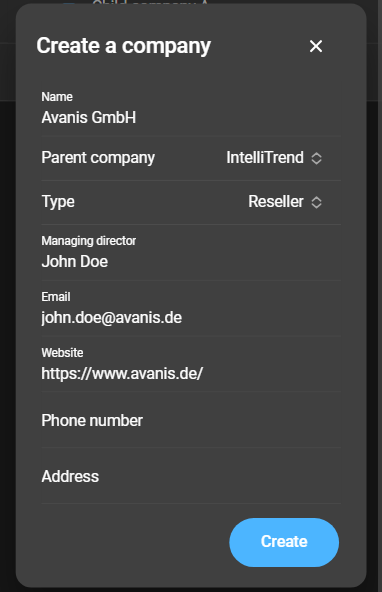
- Name: Name of the company.
- Parent company: Select a parent company. Only active reseller companies that are not descendants are displayed. If the selected company would exceed its company quota, it is not displayed.
- Type: Type of the company.
- Managing director: Name of the managing director.
- Email: Email address of the contact person/managing director.
- Website: Website of the company.
- Phone number: Phone number of the company.
- Address: Address of the company.
To set the parent company to a company whose quota limit has been reached, contact IntelliTrend user support or your reseller. More information about quotas can be found in the chapter Modules and quotas.
Complete the fields and click Create. The newly created company will be added to the list.
Configuring companies
After creating a company, it can be configured by clicking the settings icon of that company.
General
This section covers the general configuration settings. These are largely the same as those mentioned in Creating companies. However, there are two additional options: Notes and Status. Notes can be used to add information to the company, while Status indicates the availability and usability of the company.
Changing status
The status of a descendant company can be changed by clicking the Activate/Deactivate button. It is not possible to deactivate the company of the manager currently logged in. If a company is deactivated, a dialog opens where a reason for deactivation can optionally be provided. Click Deactivate again to complete the process.
- All descendants of the deactivated company are also deactivated. - It is not possible to set a deactivated company as a parent company. - It is not possible to log in as a DataForge manager of the deactivated company. - It is not possible to log in as a DataForge user of the deactivated company. - Scheduled reports and AI datasets are not processed further.
Changing parent companies
A company can be moved to a new parent company. This action is subject to the same restrictions as when creating a company. A company can only be moved to an active reseller company that is not a descendant of itself. If the selected company would exceed its company quota, it is not displayed. If a company is moved, the entire branch (the selected company and all its descendants) is moved.
To set the parent company to a company whose quota limit has been reached, contact IntelliTrend user support or your reseller. More information about quotas can be found in the chapter Modules and quotas.
The parent company can be changed by clicking Parent company. This opens a dialog where all available options are displayed.
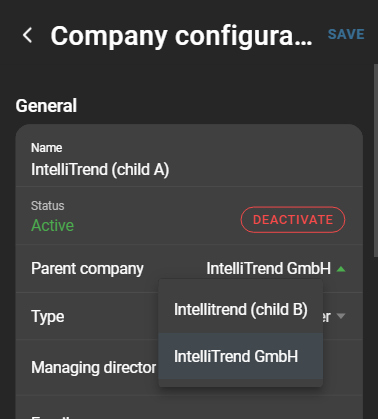
After selecting a parent company, click Ok to apply the changes.
Branding
The branding section customizes the design of the rendered PDF report and adds personalized branding.

- Company name: Name of the company, displayed beneath the company logo.
- Company logo: Upload an image (.png, .jpg or .svg) of the company logo. Displayed in the header.
- Primary color: Primary color for the PDF report. Used for line charts and smaller elements.
- Secondary color: Secondary color for the PDF report. Used for line charts.
- Background color: Background color for the report. Does not affect card or header/footer colors.
- Card background color: Background color of the cards.
- Text color: Text color of the report (not header/footer).
- Header/Footer background color: Background color of header and footer.
- Header/Footer text color: Text color of header and footer.
- Reset to default colors: Reset all branding options to default values.
Plan
It is not possible to change the plan details for the current company; only details of descendants can be configured. These details assign a name and description to the plan used by the descendant. A plan comment can also be added, but it is only visible to the parent company.
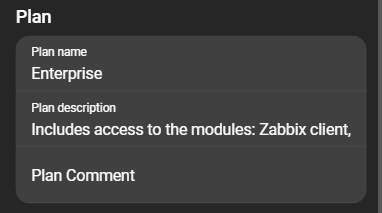
Modules and resource usages
This section provides information about modules (features) and resource quotas of the company. Available modules and quota limits depend on the purchased license and the admin. A manager of an instance with the necessary permissions can manage quota limits and modules for all companies within the branch. More information can be found in the admin manual.
Modules
Modules define access to DataForge functions, including Zabbix Client, Reporting, Self Provisioning, and AI. Availability depends on the purchased license and can be enabled or disabled by the admin.
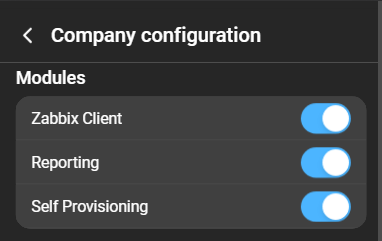
Resource usages
This section shows resource limits for the company and how many are in use. The admin can adjust the limits if required.
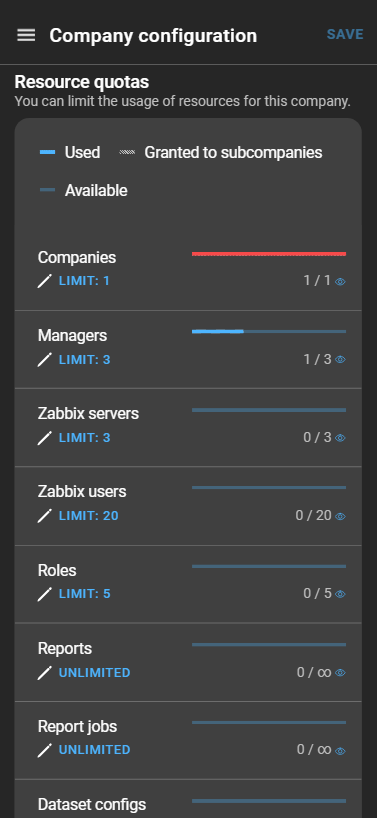
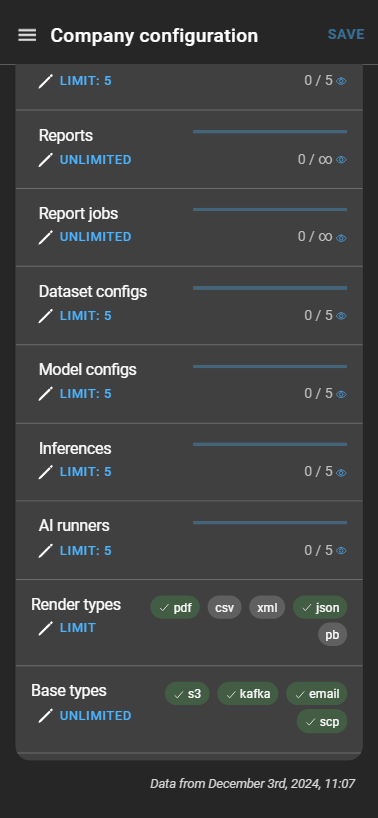
- Companies: Number of companies that can be created.
- DataForge managers: Number of managers that can be created.
- Zabbix servers: Number of Zabbix servers that can be added.
- Zabbix users: Number of Zabbix users that can be imported.
- Roles: Number of custom DataForge user roles.
- Reports: Number of reports that can be created.
- Report jobs: Number of reports that may be rendered.
- Dataset configs: Number of dataset configs.
- Model configs: Number of model configs.
- Deployments: Number of deployments.
- AI server: Number of AI servers.
- Render types: Available types when rendering reports. Configurable when subscribing to a report.
- Base types: Base types available when creating a media type.
On the right side of the resources, the indicator bar shows the following (from left to right):

-
Resources used by the company. Color changes by percentage:
- Light blue: ≤ 60%
- Yellow: > 60% and ≤ 80%
- Red: > 80%
-
Remaining resources available: dark blue.
-
Resources granted to descendants: gray hatched (only for the root company).
To view precise numerical values, click and hold the eye icon.

The numeric values beneath the indicator bar display:
- Total resources in use.
- Total limit.